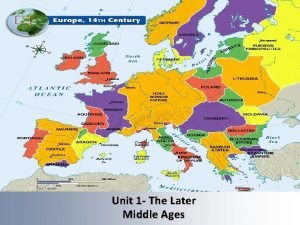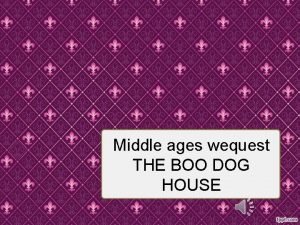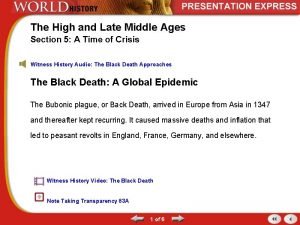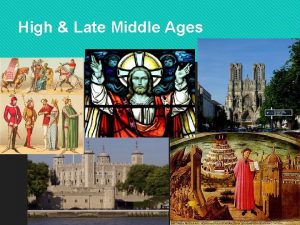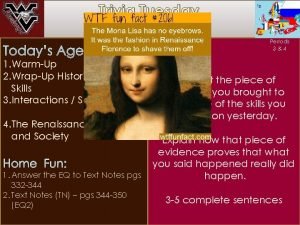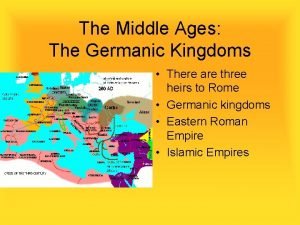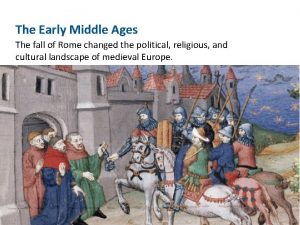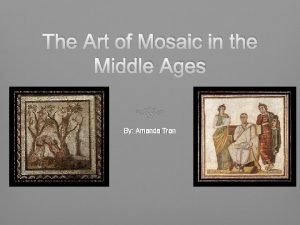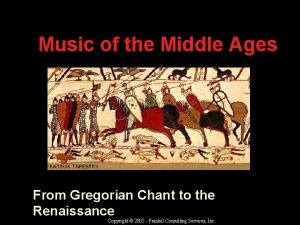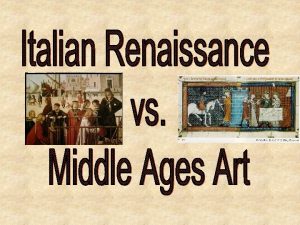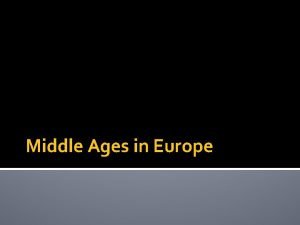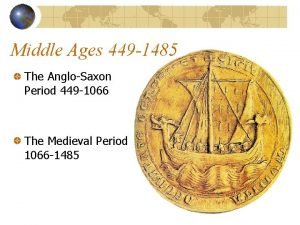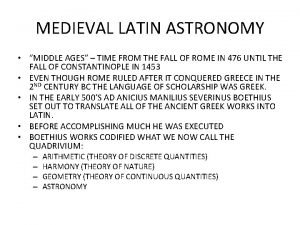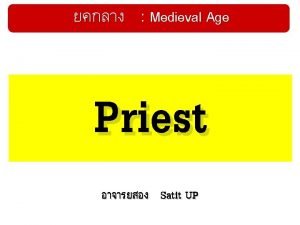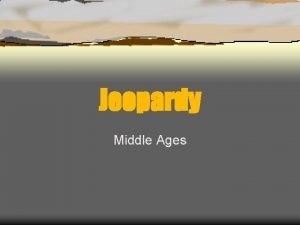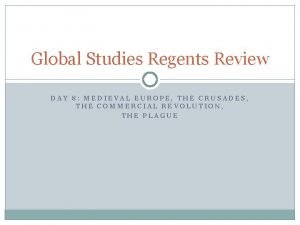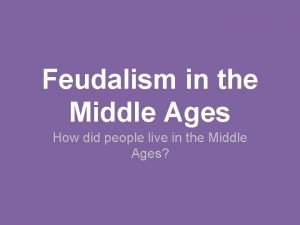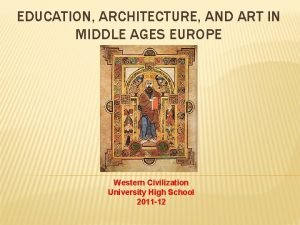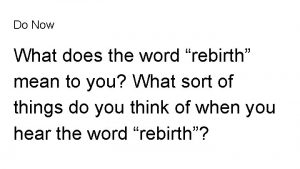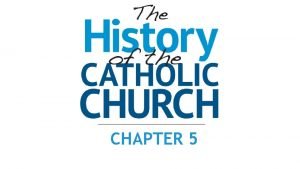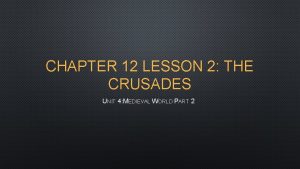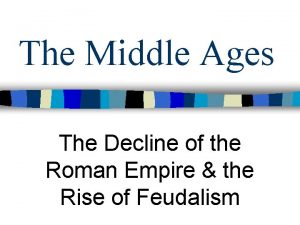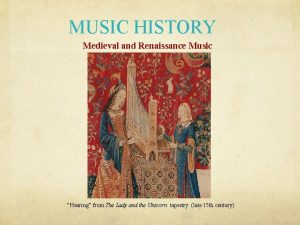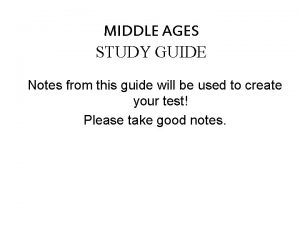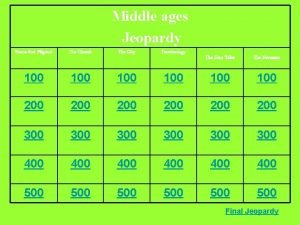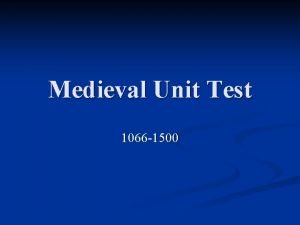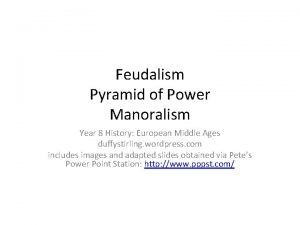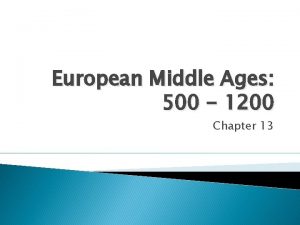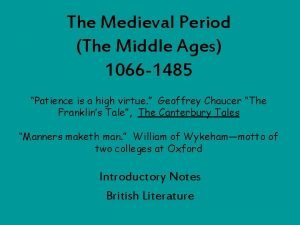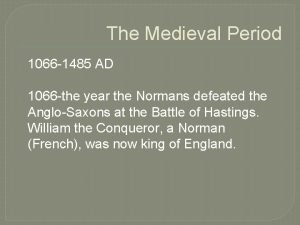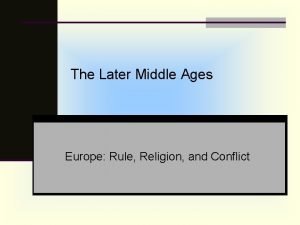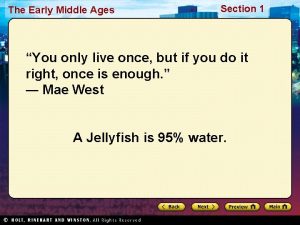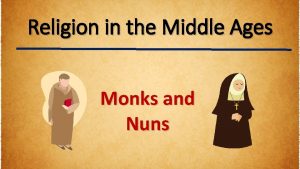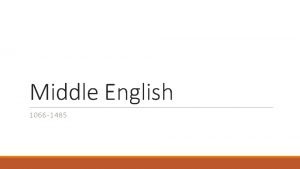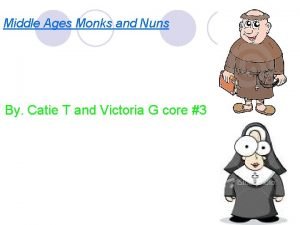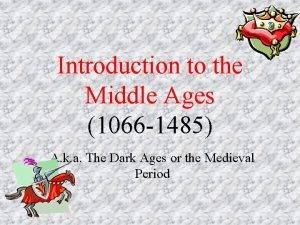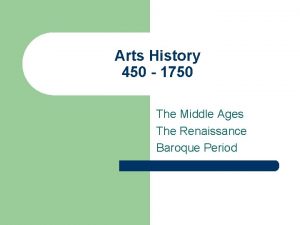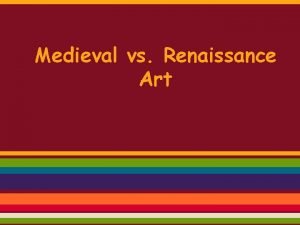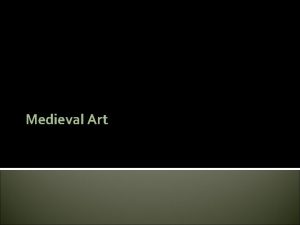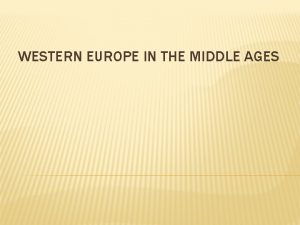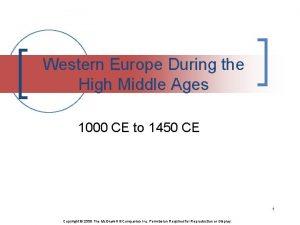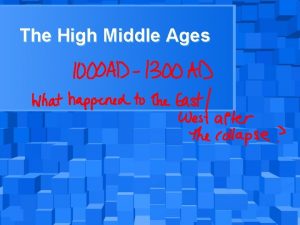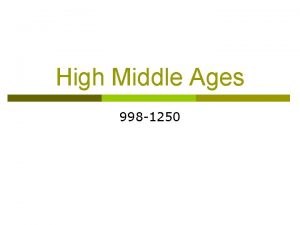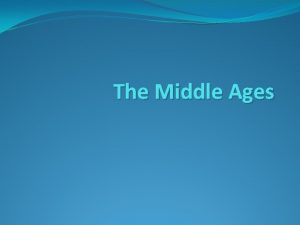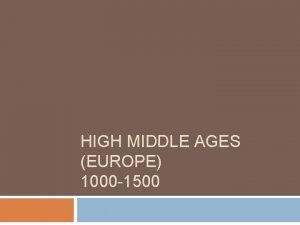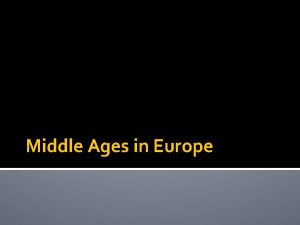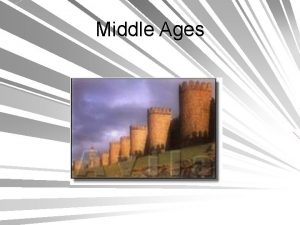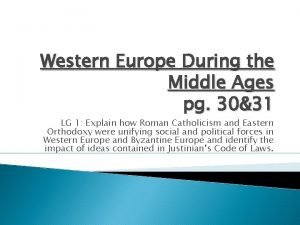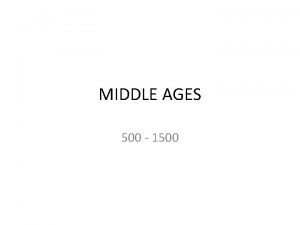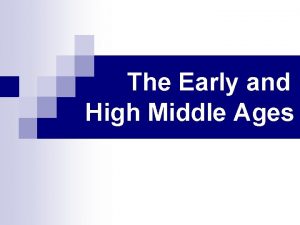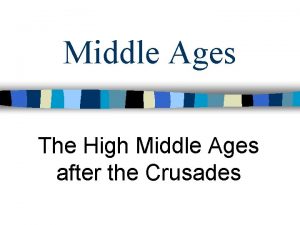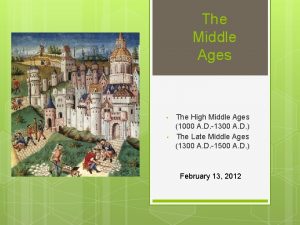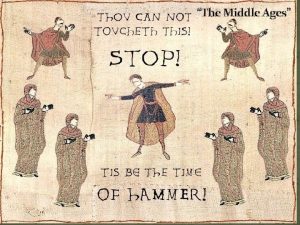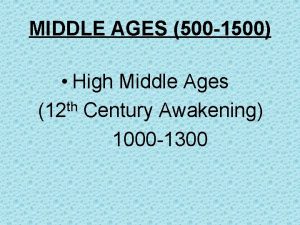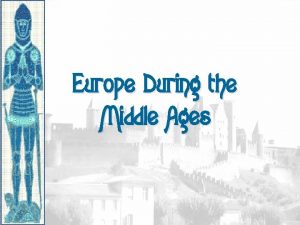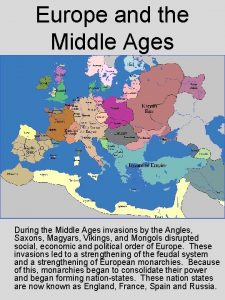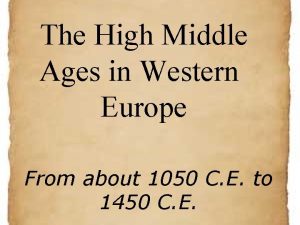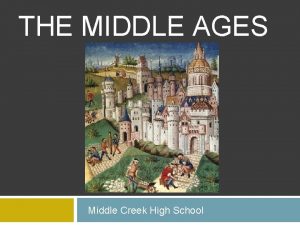Western Europe during the High Middle Ages The

















































- Slides: 49

Western Europe during the High Middle Ages

The Establishment of Regional States n Holy Roman Empire n France n England n Italian States

High Middle Ages n 1000 – 1300 CE n Europeans built a vibrant and powerful society on the political, economic, and cultural foundations of the early Middle Ages

Holy Roman Empire Late 10 th c. , German princes formed it n Viewed as a revival of the Roman Empire, however never really was n Otto I or Otto the Great – Extended their rule to eastern Europe – B/c of his aid to the Church, he was crowned emperor in 962 – Despite this, tension surrounded popes/emperors n Investiture contest n – Gregory VII banned lay investiture – Emperor Henry IV rejected policy – Pope intervenes w/ help of supportive German princes – Gives German princes more power and diminishes Emperor n Frederick Barbarossa n “the Red Beard” n 1152 CE -1190 CE n Sought to absorb N. Italy however popes w/ help of other European states forced him to relinquish his rights there n Another example of how papal authority limited the rule of emperor

Voltaire, 18 th century, on the Holy Roman Empire “The Holy Roman Empire is neither holy, nor Roman, nor an empire. ” Empire only in name Just a regional state that intermittently wielded influence in eastern Europe and Italy

Capetian France n Hugh Capet elected as king in 987 CE by the lords of France n Held only small territory around Paris n Capetian kings gradually added resources and political influence n By 14 th c. , they had gradually centralized power and authority in France Coronation of Philip II of France

King Louis IX (reigned 1226– 1270), also known as St. Louis, helped to consolidate the Capetian hold on the French monarchy. In this fourteenth-century manuscript illustration, he hears the petitions of humble subjects (right), while hanged criminals (left) serve as a reminder of felony's results.

Norman England n Descendants of the Vikings in France (Normandy) n 1066 William, Duke of Normandy, invades England at Battle of Hastings to become King n Rule is more centralized than Capetian kings n Periodically battled w/ Capetian kings to expand possessions in France

Bayeux Tapestry in Normandy The Bayeux tapestry, a magnificent mural of woven linen about 70 meters (230 feet) long, depicts the Norman invasion and conquest of England in 1066. In this section Norman warriors sail across the English Channel and disembark in southern England.

Italian States n No single regime controlled peninsula n “Ecclesiastical” states – Popes and bishops of major cities had huge influence in political affairs n - City-states – Florence, Bologna, Milan, Venice etc. n Papal States – Central Italy – Popes rule n Normans conquer Southern Italy – Laid foundation of kingdom of Naples – Helped conquer from Byzantine and Muslim authorities in South Florence grew rapidly during the High Middle Ages -early 14 th century.

Christian and Muslim States In Iberia n Regional states n Muslims ruled most of peninsula from 8 th – mid 11 th century n By 13 th c. , Christian kingdoms of Castile, Aragon, and Portugal controlled most of Iberian Peninsula n Granada only Muslim kingdom


Agriculture n Expansion of arable land – Clear forests, drain swamps – By 1300, forest cover reduced to 20% of land area n Improved techniques – 3 field system n New tools and technologies – Water mills and windmills – Heavy plows – Horseshoe and horse collar n New crops – Beans, peas – Wheat, rice, spinach, artichoke, eggplant, lemon, lime, oranges, melon

European Population 800 -1300 CE

Growth of Towns and Trade n Urbanization w/ increase of food – Paris, London, Toledo n Increasing manufacturing and trade – Textile production n Mediterranean trade – Urban society most pronounced in Italy – Merchants in Venice engage in trade w/ Byzantine & Muslim partners

Venice, home of Marco Polo and a legion of merchants, drew enormous prosperity from trade. Street vendors, shopkeepers, and merchant ships figure prominently in this illustration from a fourteenth-century manuscript. How did its geographic location help Venice become a center of Mediterranean trade?

Hanseatic League n The trade network that grew in the North and Baltic Sea – Also known as the Hansa – Banned together to establish common trade practices or monopoly from region to world – Over 100 cities join n Dominates trade in fish, fur, timber, and pitch n Rivers link it to the Mediterranean trade networks n Significance: Leads to large middle-class in Northern Europe and sets precedent for the Dutch and English Trading Companies Hanseatic League *Stretched from Novgorod, Russia to London

Improved Business Techniques n Development of credit, banking – Ex. Letters of credit v Didn’t have to carry large amounts of cash or bullion v W/out them, it would be impossible to carry out longdistance trade n Partnerships with other merchants to spread out risk n Genoese bankers change money and check the accounts of their clients in this fourteenth-century manuscript illustration.

Social Change n The Three Estates 1. Those who pray: clergy – Priest, bishop, cardinal, popes 2. Those who fight: knights – Nobles, inherited position, educated in military 3. Those who work: peasants – Majority of population n Society marked by political, social, economic inequality

Chivalry n Code of conduct for nobles – Compared to bushido in Japan n Sponsored by Church to minimize fighting among Christians n Technically, knight to dedicate his efforts to promotion of Christianity – Devote himself to order, piety, and Christian faith – Protection of women

Troubadours n Class of traveling poets, minstrels, entertainers n Borrowed Islamic traditions of love poetry n Spread of cultural ideas to Europe – Popular among aristocratic women – Eleanor of Aquitaine (11221204) major supporter A thirteenth-century manuscript n Popularization of idea of romantic illustration depicts two lute players: Muslim (left) and Christian (right). Muslim love, refinement of European artists deeply influenced the poetry and knights music of the medieval troubadours.

Guilds

Urban Women n Fresh opportunities for women in cities as well as men n Most guilds admitted them n Work along w/ men – Baker, brewer, candle maker, fishmonger, shoemaker etc. n Dominated certain professions – Sewing, spinning, weaving, making hats, wigs, fur garments

European Christianity During High Middle Ages n In cities, increase in wealth allowed more resources for education n Started w/ Cathedral Schools – Curriculum of Latin writings – Emphasize literature, philosophy v Bible, writings of Church fathers – Some law, medicine, theology A manuscript illustration depicts a professor, at top left, lecturing in a medieval German university. About half the students listen and take notes diligently, while the others catch up on their sleep or chat with friends.

What can be learned from the following map?

Universities n Academic and faculty guilds formed in 12 th century – Bestow academic degrees that served as licenses to teach – Control the curriculum n Higher standards of education promoted University of Paris-Sorbonne University of Oxford

Influence of Aristotle n Latin translations of Byzantine Greek texts circulate in Europe n Jewish and Muslim scholars provide other translations from Arabic translations n Leads to scholasticism n Synthesis of Christianity and Aristotle n St. Thomas Aquinas(1225 -1274), major proponent of Scholasticism – Career at University of Paris – Summa Theologica – Synthesized faith and reason St. Thomas Aquinas 1225 -1274

Popular Religion n Population at large remained unaffected by n n n Here a 14 th century stained glass window from the Notre Dame n Cathedral in Evreux, France, represents the Virgin holding the infant Jesus in the company of an n admirer. Scholasticism The Seven Sacraments gain ritual popularity – Esp. Eucharist Devotion to Saints – Pray for saints to look after their spiritual interests Most popular saint: The Virgin Mary – Ideal mother – 100 s of churches and cathedrals devoted to her – Notre Dame dedicated to her “Our Lady” Saints’ relics – Venerate relics or physical remains – Ex. Clothes, locks of hair, teeth, bones Pilgrimage to Rome, Jerusalem etc.

Notre Dame in Paris

Reform Movements n Rebellion against perceived materialism of Roman Catholic Church n St. Dominic (1170 -1221) and St. Francis (1182 -1226) create orders of mendicants or “beggars” – Vows of poverty n Popular preachers n Religious zealots, very opposed to heretical movements


The Medieval Expansion of Europe n Atlantic and Baltic Colonization – Scandinavians explore North Atlantic Ocean v. Iceland, Greenland, Vinland (Canada) v. Canadian settlements do not succeed – Kings of Denmark nominally convert to Christianity, Sweden and Finland follow

Reconquest of Sicily and Spain n Expansion of Christian Europe in Med. n Sicily taken by Muslims in 9 th century, reconquered by Normans in 11 th century – Missionaries and clergy reintroduce it – Muslims scholars introduced them to Arabic translations that led to scholastic philosophers n Reconquista of Spain – Began in 1060 s – Christian forces lured reinforcements from France and England – Campaigns led forces all the way to kingdom of Granada – Granada survives until 1492

The Beginning of the Crusades n Pope Urban II calls for liberation of Jerusalem from Muslim control, 1095 n Salvation promised for casualties n Rapid, enthusiastic response n Peter the Hermit raises popular frenzy – Organizes a ragtag army (no training, discipline, weapons, supplies or plans) – Fought Greeks, Turks and themselves on way – Some died, captured by Turks & sold into slavery – Few made it to Jerusalem “Deus vult-”God Wills It”

First Crusade n 1096 -1099 more organized expedition n Captures Jerusalem, largely due to poor Muslim organization n Salah al-Din (Saladin) recaptures Jerusalem in 1187

Fourth Crusade During the sack of Constantinople in 1204, crusading forces seized and carted away Byzantine treasures of all sorts-including the great bronze horses that now stand over the entrance to St. Mark’s Basilica in Venice.

Atrocities during the Crusades The Crusades involved brutal conflict and atrocities from all sides. In the 12 th century manuscript illustration, crusaders lob severed heads at Muslims defending a fortress.

Atrocities A 14 th century manuscript illustration depicts Muslims burning captured crusaders at the stake.

Christians and Muslims This fourteenth-century painting illustrates the Christian seizure of Jerusalem during the First Crusade in 1099. The crowned figure in the center is Godefroi de Bouillon, a French knight and nobleman who played a prominent role in the attack and was briefly known as the king of Jerusalem. (Snark/Art Resource, NY)

Later and Consequences of Crusades n Failure as military venture, but reason for European reintegration into the eastern hemisphere n Five crusades by mid-13 th century, none successful n Fourth Crusade destroys Constantinople, 1202 -1204

Consequences of the Crusades n Provides direct contact with Muslim ideologies, trade – Aristotle, “Arabic” numerals, paper production – New foods, spices, silk, cotton textiles, carpet, tapestries n Demand for new commodities increased allowing Italian merchants to develop and market them in port cities – Ex. Marco Polo n Travel well beyond Egypt, Palestine to avoid Muslim intermediaries

n An illustration from a manuscript of 1282 depicts a Christian (left) playing chess with a Muslim (right). Chess was one of many cultural elements that passed from Muslim to Christian societies during the crusading era.

The Black Death A painting of 1503 graphically communicates the horror felt by medieval Europeans when bubonic plague struck their communities. Here death takes away a cartload of victims while others die beside the road.

The Flagellants

Burying the Dead

Culture of Death In the inscriptions at the bottom of the painting, each living character addresses a skeletal figure, who in turn makes a reply. Here is the exchange between the empress (shown in a red dress at the far right of the image) and Death. First, the empress speaks: Empress: I know, Death means me! I was never terrified so greatly! I thought he was not in his right mind, after all, I am young and also an empress. I thought I had a lot of power, I had not thought of him or that anybody could do something against me. Oh, let me live on, this I implore you! Death’s reply: Empress, highly presumptuous, I think, you have forgotten me. Fall in! It is now time. You thought I should let you off? No way! And were you ever so much, You must participate in this play, And you others, everybody— Hold on! Follow me, Mr Cardinal!47

Questioning of Faith In the late-fourteenth-century clergyman in England expressed the dismay that many must have felt: “For God is deaf nowadays and will not hear us And for our guilt, he grinds good men to dust. ” The captions, from top to bottom, read: Christ figure: “Tho it be late ere thou mercie came: yet mercie thou shalt have. ” Priest figure: “Commit thy body to the grave: pray Christ thy soul to save. ” Death figure: “I have sought thee many a day: for to have thee to my pray. ” * How do these captions influence your understanding of the painting?

Assessing motives: Do you think the artists who created these visual sources sought to reinforce traditional Christian teachings or to challenge them? n Using art as evidence: What do these visual sources tell you about the impact of and responses to the plague in fourteenth-and fifteenth-century Western Europe? n Connecting past and present: Considering the various ways that people sought to avert, cope with, or explain the plague in these visual sources, what parallels to the human responses to crises or catastrophes in more recenturies or in our own time can you identify? n

English forces besiege a French citadel during the Hundred Years' War (1337– 1453). Note that the besiegers on the left side of this manuscript illustration employ cannons and smaller firearms that launch gunpowder bombs.
 Dark ages def
Dark ages def Renaissance vs medieval art
Renaissance vs medieval art Map of europe in middle ages
Map of europe in middle ages Discuss the art of emerging europe.
Discuss the art of emerging europe. Around 900 ce a new form of government called
Around 900 ce a new form of government called The high and late middle ages section 5 quiz
The high and late middle ages section 5 quiz Copyright
Copyright High middle ages
High middle ages Renaissance vs middle ages
Renaissance vs middle ages Germanic kingdom
Germanic kingdom Egyptian time period floral design
Egyptian time period floral design Early middle ages
Early middle ages Mosaic art in medieval period
Mosaic art in medieval period Late middle ages timeline
Late middle ages timeline Gregorian chant middle ages
Gregorian chant middle ages Dark ages vs renaissance
Dark ages vs renaissance Feudalism def
Feudalism def Middle ages description
Middle ages description Astronomy in the middle ages
Astronomy in the middle ages Hierarchy middle ages
Hierarchy middle ages Middle ages jeopardy
Middle ages jeopardy Middle ages regents questions
Middle ages regents questions Feudal system in the middle ages
Feudal system in the middle ages Education in middle ages
Education in middle ages What word means rebirth
What word means rebirth Similarities between middle ages and renaissance
Similarities between middle ages and renaissance Middle ages def
Middle ages def Chapter 12 lesson 4 the late middle ages
Chapter 12 lesson 4 the late middle ages Middle ages
Middle ages The middle ages spans nearly one thousand years
The middle ages spans nearly one thousand years Middle ages study guide
Middle ages study guide Middle ages jeopardy
Middle ages jeopardy The middle ages 1066 to 1485 unit test
The middle ages 1066 to 1485 unit test Victorian period floral design
Victorian period floral design Feudal pyrimid
Feudal pyrimid Eleanor of aquitine
Eleanor of aquitine The middle ages outcome the power of the church
The middle ages outcome the power of the church Medieval time
Medieval time The middle ages 1066 to 1485 unit test
The middle ages 1066 to 1485 unit test Early middle ages
Early middle ages Middle ages nobles
Middle ages nobles Sacred music of the middle ages
Sacred music of the middle ages Monks and nuns in the middle ages
Monks and nuns in the middle ages The middle ages 1066 to 1485 unit introduction
The middle ages 1066 to 1485 unit introduction Monks and nuns middle ages
Monks and nuns middle ages The middle ages 1066 to 1485 unit test closed book
The middle ages 1066 to 1485 unit test closed book 450/1750
450/1750 Middle ages
Middle ages Medieval vs renaissance art
Medieval vs renaissance art Characteristic of medieval art
Characteristic of medieval art


